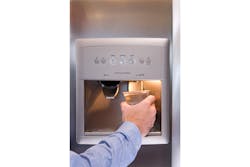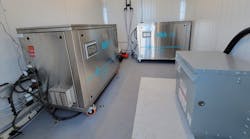Public perceptions of drinking water acceptability have been trending negatively since the passage of the Safe Drinking Water Act (SDWA) in the mid-1970s. This indicates more public sensitivity to drinking water issues, but it is counterintuitive because public drinking water quality has consistently improved since then and has probably never been better on a national scale. Studies that led to the passage of the SDWA demonstrated inconsistency in meeting public drinking water quality specifications, especially in small water systems. Most large systems were in compliance with the existing U.S. Public Health Service drinking water requirements.
The Water Quality Association (WQA) recently published the results of a national telephone survey of 1,200 adults living in private households. WQA is the international trade association representing the household, commercial and industrial water quality improvement industry. Results were reported by the market research firm that conducted the telephone survey, accurate within 2.8 percent. The results are found in the 2015 Study of Consumers’ Opinions and Perceptions Regarding Water Quality. The fifth survey that WQA has conducted during the last 11 years, it shows a continuation of some trends regarding public perceptions about drinking water quality and people’s drinking water choices in response to those views.
Survey content and findings by topic
The survey consisted of a series of water-related questions that respondents answered. Several of the key questions and response rates are provided below with some comments and comparisons of results from the 2011 or 2013 surveys.
- Overall concern with quality of household water. Fifty-six percent of respondents (up from 52 percent) were very or extremely concerned about their water quality, while 23 percent (down from 25 percent) were not very concerned. The responses were slightly more concerned or close to the experimental accuracy range.
- Concern about health contaminants. Fifty-nine percent (up from 54 percent) were very or extremely concerned, while 19 percent (down from 24 percent) were not very concerned. These results are more robustly outside the 2.8 percent accuracy range.
- Primary responsibility for safe drinking water. Seventy percent, consistent with earlier studies, said that the responsibility belonged with the municipality. Twenty-two percent said the responsibility was with home water treatment products and eight percent with a bottled water plant. This result is somewhat inconsistent with later responses relating to the consumption of bottled water or the use of home water treatment devices.
- Consumption from drinking water sources. The question was: Do you currently use any of the following? The responses were:
- 77 percent compared to 65 percent in 2011 indicated that they use bottled water.
- 43 percent compared to 49 percent in 2013 have a not fully defined home water filtration product.
- 45 percent compared to 34 percent in 2011 have a refrigerator water filter.
- 16 percent versus 15 or 16 percent have a water softener.
Bottled water usage increased, but it is likely not exclusive bottled water usage, which could not be determined from the question. Home water softener usage did not change from 2011 to 2015. It is clear that significantly more new refrigerators are being sold with installed filters. Apart from refrigerator filters, the home water filter usage rate was about the same as in 2011.
- Reasons for purchasing bottled water. The taste of tap water and the convenience of bottled water were consistent in the 40 percent range. Safety and health concerns were consistent at about 23 to 26 percent of responses. Other tap water quality elements, such as the appearance and odor of tap water, were consistent in the 14 to 16 percent range. The percentages are not additive because of multiple responses.
- Reasons for purchasing a filtering system. Among the approximate 43 percent of respondents who purchased a filtration product, 40 percent stated that they were motivated by the taste of the tap water, and 50 percent were concerned about contaminants. These are not additive because of multiple responses. The approximate 25 percent of all respondents who were concerned with health risks is consistent with the bottled water purchasers. The range of filtration product types that consumers used was not fully defined.
- Impact of the "green" movement. Apparently, this question was related to concerns about plastic bottles. Seventy-eight percent said they would still buy bottled water and nine percent had stopped buying bottled water. Another 6 percent switched from bottled water to a home filter. About 15 percent of them had seemingly eliminated their use of bottled water, but this does not appear to be entirely consistent with the increased bottled water consumption noted in other studies.
- Reasons for purchasing a filtration system. Forty-eight percent stated that notifications of unsafe water or boil water notices led to the purchase of a filtration system. Seventy-seven percent purchased a pitcher water filter, end of faucet device or refrigerator filter. This response has some ambiguities since on average only about 3 percent of public water systems issue boil water or similar notices in a typical year. Fifty-six to 66 percent of respondents expressed willingness to pay for a water treatment system if it could remove certain contaminants.
- Perceived contaminants in tap water. About 80 percent were concerned about chlorine, about 70 percent lead, 50 percent microbiologicals, 42 percent arsenic, 36 to 39 percent pharmaceuticals, 24 percent radium, 20 percent chloramine, and 12 percent methyl tertiary butyl ether (MTBE). These do not add up to 100 because of multiple allowed responses. These responses are puzzling because most of the contaminants are regulated and do not pose significant health risks to public drinking water.
- Chlorine is commonly used in drinking water treatment and free chlorine is often noticeable since the taste threshold of free chlorine is temperature-dependent, but an approximate value of about 0.6 milligrams per liter (mg/L) is frequently reported. The taste threshold for chloramine can be as high as 5 mg/L. The maximum permissible levels in drinking water are 4 mg/L, but most water supplies are well below those values. Numerous public water systems have converted from free chlorine to chloramine residuals during the last 30 years, so the frequency of chlorine taste detection should be declining.
- Lead would be a concern only in homes connected to water systems that still have some lead service lines and that do not also provide proper corrosion control required by the Lead and Copper Rule.
- Microbiologicals are under exceptional control in public water systems because of broad filtration requirements for surface waters and disinfection requirements for vulnerable groundwater. Gastroenteritis microorganisms are readily controlled by water treatment. Waterborne disease outbreak numbers are low and have consistently declined since the implementation of the SDWA in the 1980s. From 2011 to 2012, 11 incidents of water-related gastrointestinal disease were reported by the Centers for Disease Control in more than 150,000 public water systems, so the risk is slight.
- Arsenic is regulated and primarily a concern in a few thousand extremely small public water systems and an unknown number of private wells that have difficulty providing treatment.
- Pharmaceuticals have been detected at parts per trillion levels in some surface water supplies. The World Health Organization concluded they were not a public health concern in drinking water.
- Radium is regulated and seldom found in surface waters and infrequently found above the regulated value in groundwater systems in certain areas of the country. It is readily treated by water softening methods.
- MTBE is a potential groundwater contaminant formerly used as a gasoline additive that has a noticeable odor at 20 parts per billion (ppb) and taste at 40 ppb. It is not toxic below those levels and would be readily detected if present.
Conclusion
The WQA survey of consumer opinions and perceptions provides interesting insight into the concerns of consumers regarding the aesthetics, quality and safety of their tap water as well as their motivations for accessing bottled water or home treatment devices. Several of the 2015 response rates were not statistically different from the 2011-2013 period. The trend of increasing public dissatisfaction with tap water and using alternatives has continued since the 1970s when the visibility of drinking water quality issues increased commensurate with the development of increasingly sensitive analytical methods that allowed detections not previously possible.
Also interesting is that carbon tap and refrigerator filters are the most popular home treatment devices, and their long-term strengths are in the removal of chlorine and other taste-sensitive chemicals that may reduce desirability but are not public health concerns. Some pitcher filters remove other trace components. Apparently, boil water notices do not necessarily lead to purchases of treatment devices that control pathogenic microorganisms, and health concerns do not necessarily encourage consumers to purchase more expensive devices designed for long-term removal of trace chemicals (for example larger carbon filters or reverse osmosis devices). Water softeners are effective in reducing hard water that improves water characteristics for domestic uses, and they will remove radium, barium and strontium in addition to calcium and magnesium.
The survey provided much useful information on public perceptions and attitudes about drinking water and the impact of the media on public opinion. Perhaps additional detail is available on the study, such as on the composition and geographic distribution of the respondents, that would refine the interpretations of the results. For example, what was the breakdown between the public water system and private well users, since wells are more likely to have water quality issues?
Many in the public decide to exercise their options, treating drinking water as a beverage choice rather than a commodity, and they consume more bottled water and use home treatment devices. This is probably partly because of the greater availability and convenience of bottled water and home treatment devices and more discretionary income, but it is also driven by people’s dislike of the taste of some tap water and their reactions to media reports that stimulate concerns about hypothetical risks that may be related to drinking water.
What is clear is that in many cases consumers perceive that their tap water is of lesser quality than it really is, and they often do not make the appropriate technology choices that relate to their concerns. It is also clear that water suppliers should be more concerned about the aesthetic quality (for example, undesirable taste or excessive hardness) of their product beyond just meeting regulatory requirements.
Water for drinking and cooking makes up only about 1 percent of the tap water provided by the public water supplier and consumers have several beverage choices. The water industry and regulators should do a better job of educating the public about the actual risks and technologies that are appropriate for treating their water to make it more desirable. In addition, private water supplies (home wells) are much more likely to be a quality and health risk concern than public supplies because they are usually not managed or treated for microbials or natural or synthetic chemical contaminants, such as those from septic tanks or pesticide migration.
Dr. Joe Cotruvo is president of Joseph Cotruvo and Associates, LLC, Water, Environment and Public Health Consultants. He is a former director of the EPA Drinking Water Standards Division.


